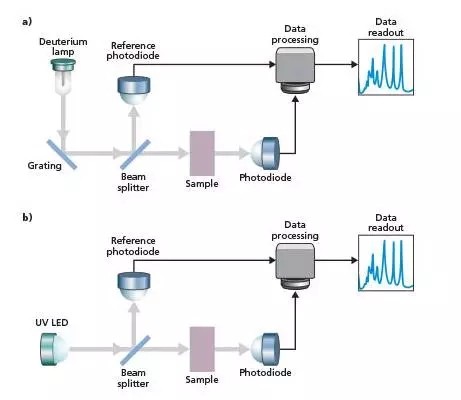Many laboratories in the life sciences rely on fast, accurate, and reliable measurements, especially in applications like high-performance liquid chromatography (HPLC) and DNA concentration and purity analysis. These processes depend heavily on quantitative analysis through absorption spectroscopy. As a result, leading instrument manufacturers are exploring alternative light sources, such as UV-C LEDs (in the 100–280 nm range), to meet evolving user demands. UV-C LEDs offer a compelling solution by enabling smaller, more cost-effective instruments that can help companies stand out in a competitive market.
While UV LEDs in other spectral regions have been widely adopted, UV-C LEDs face challenges due to lower efficiency, particularly at the higher end of their wavelength range. However, despite these limitations, they remain highly valuable in many test and measurement-focused applications within the life sciences.
Lab professionals are increasingly seeking compact, affordable instruments that can boost productivity without compromising performance. Emerging technologies are driving the miniaturization of lab equipment, which not only reduces costs but also makes it easier for researchers to integrate testing into their daily workflows. With low-cost, small-scale LED-based systems, scientists can perform routine measurements directly on their benches. When full-spectrum analysis is needed, more advanced and expensive UV lamps can still be used in central lab setups, helping reduce bottlenecks and improve overall efficiency.
In the past, the performance of UV-C LEDs was a limiting factor for instrument developers. However, recent advancements in LED technology have significantly improved their stability and output. This has enabled manufacturers to introduce new instrument models that better meet current market needs. In this article, we will explore several key applications where UV-C LEDs are making a real impact.
UV-C LEDs Enable Fixed Wavelength Detection in HPLC
High-performance liquid chromatography (HPLC) is a powerful technique used to separate mixtures based on differences in their partitioning between the mobile and stationary phases. As compounds move through the column, they elute at different times, allowing for individual detection. Traditionally, UV spectrophotometers have been used to detect these components based on their absorption spectra. HPLC is widely applied in pharmaceuticals, biotechnology, food safety, and quality control.
Most HPLC detectors currently use xenon lamps as their light source because of their high stability over time. The consistent light output ensures accurate detection of low-concentration compounds. Compared to other UV sources like mercury or xenon flash lamps, xenon lamps offer much greater stability—up to two orders of magnitude better. This makes them ideal for precise, repeatable measurements.
LEDs Meet Stability Demands
New high-performance UV-C LEDs now match the stability of high-end xenon lamps, with peak fluctuations below 0.005%. They provide similar sensitivity while significantly reducing the size and cost of fixed-wavelength detection systems. This makes them an attractive option for labs looking to optimize space and budget. Additionally, LEDs have a longer lifespan and turn on instantly, eliminating the need for preheating, unlike xenon lamps. Their light can also be easily fiber-coupled, which is beneficial in applications requiring isolation of the flow cell.
For fixed-wavelength HPLC systems, the main cost difference often lies in the initial configuration, including the light source and supporting components. An HPLC system using an LED detector typically requires a power supply, a photodiode, and a beam splitter. The total cost for such a system is approximately $750. In contrast, systems using xenon lamps require more expensive power supplies and additional space for the lamp itself. Moreover, xenon lamps emit broad-spectrum UV light, which necessitates costly filters and monochromators for fixed-wavelength detection. As a result, typical system costs can reach around $4,000. Figure 1 illustrates the optical path differences between a xenon lamp-based system (a) and a UV-C LED-based one (b).

Figure 1 shows that the optical path of a fixed wavelength HPLC detector using a xenon lamp (a) is more complex than that of a UV-C LED-based system (b).
Lowering the Cost of DNA Purity Measurements
Another promising application of UV-C LEDs is in DNA concentration and purity measurements. Accurate DNA extraction is critical for biological research, impacting fields such as genomics, forensics, and drug development. It plays a key role in detecting genetic disorders, creating DNA fingerprints, and producing genetically modified organisms.
In these applications, speed and accuracy are essential for improving productivity and reducing costs. DNA and proteins absorb light at 260 nm and 280 nm, respectively. The ratio of absorbance at these wavelengths helps determine DNA purity. Traditional spectrometers for these measurements often use xenon flash lamps, which offer instant on/off capability and allow for rapid, high-linearity measurements across a wide concentration range.
However, broad-spectrum UV lamps like xenon flash lamps produce light across many wavelengths, most of which are not relevant for single-parameter measurements. To isolate the necessary wavelengths (such as 260 nm and 280 nm), additional optical components like filters and mirrors must be used. This increases the complexity and cost of the system. Xenon flash lamps also require high voltages, adding to the need for protective electronics. All of these factors contribute to higher overall instrument costs.
Piezo Siren,Piezo Alarm,round Piezo Siren,round Piezo Alarm,Waterproof Piezo Alarm,Waterproof Piezo Siren,IP67 Piezo Siren
Gaoyou Huasheng Electronics Co., Ltd. , https://www.yzelechs.com
